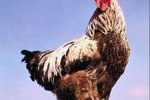Male and female chicks look just alike in the earliest days of their lives. As your fully little chicks start to develop into mature adults, you will notice unique features start to develop. The red growth that you see under the beaks of both hens and roosters is called a wattle.
Combs and Wattles
The red fleshy growth on top of your chicken's head is called a comb, and the similar growth below her chin is a wattle. Both roosters and hens have combs and wattles, though the combs and wattles on roosters are often larger and more noticeable than those of hens. The size and shape of the wattle and the comb will vary depending on the breed of the bird and the distinct characteristics of the individual animal.
Purpose
The comb and the wattle share a unique purpose. The wattle and comb work to improve your bird's blood flow. These growths help circulate blood around the chicken's head, which helps keep the chicken cool during hot temperatures.
Mating
Scientific research has shown that chickens are naturally attracted to the rooster with the largest, most noticeable wattle, according to Smithsonian Magazine. Brightly colored, healthy wattles are signs of good health that can help attract members of the opposite sex to choose the hen or rooster as a desirable mate. Among chickens of the same gender, the size and color of the comb and wattle can help establish a dominance or pecking order.
Development
Chicks are not born with a wattle but they begin to develop one within their first month of life. As the pullet, or young hen, develops, her wattle will grow and become a brighter shade of red. The wattle finishes growing at approximately the same time when the hen reaches full maturity.
References
Photo Credits
-
Jupiterimages/Photos.com/Getty Images
Writer Bio
Jen Davis has been writing since 2004. She has served as a newspaper reporter and her freelance articles have appeared in magazines such as "Horses Incorporated," "The Paisley Pony" and "Alabama Living." Davis earned her Bachelor of Arts in communication with a concentration in journalism from Berry College in Rome, Ga.




